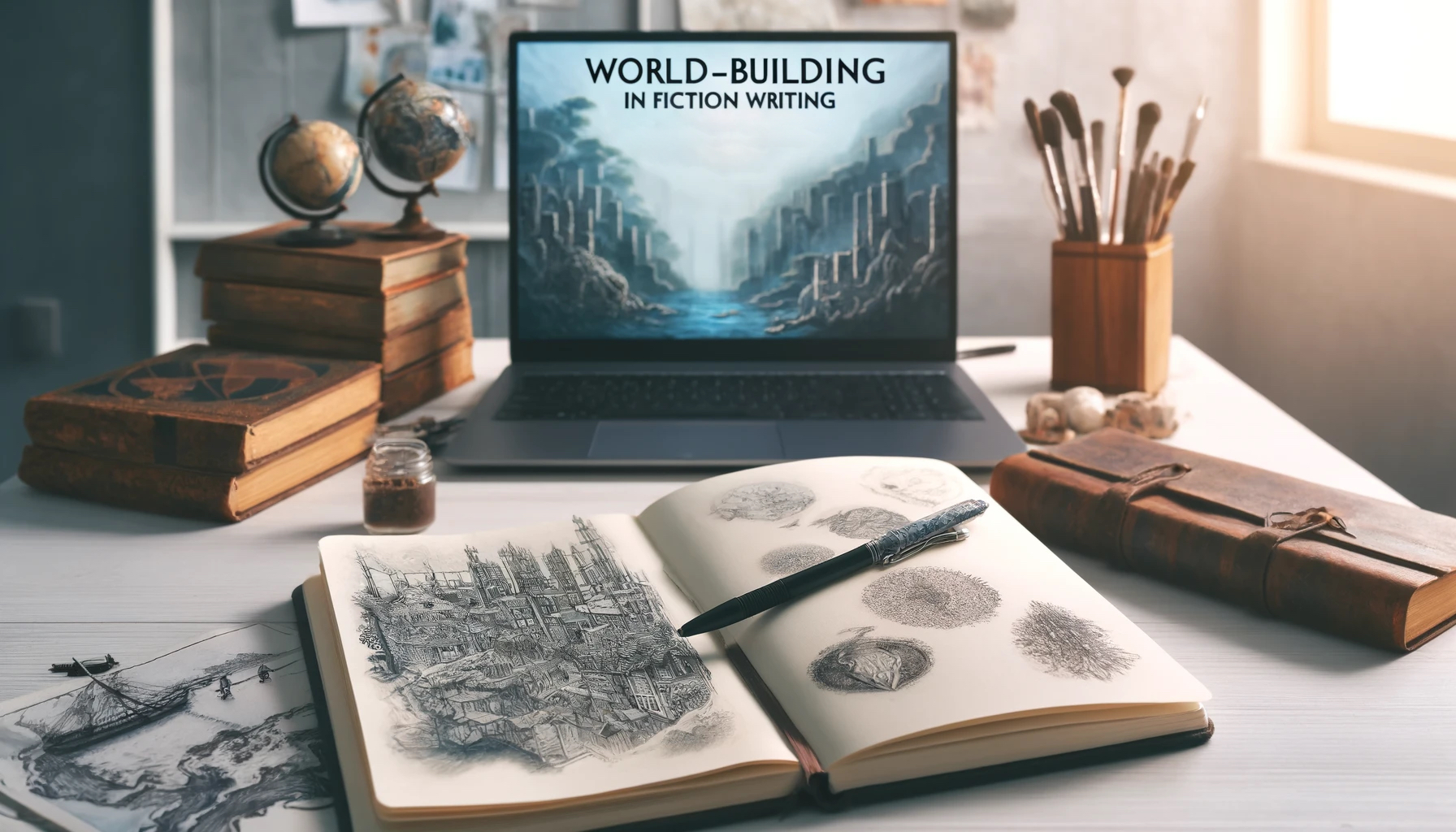Table of Contents
ToggleIntroduction
A Beginners Guide To World Building In Fiction One of the most fascinating and important parts of writing fiction is creating a world, particularly for genres like historical fiction, science fiction, and fantasy. It’s the craft of developing a distinctive, captivating universe where your themes, characters, and story will develop.
Whether you’re writing about a dystopian future, an alternate Earth, or a vast high fantasy land, world-building is essential to giving your novel a realistic, vivid, and captivating feel.
The breadth of world-building may be too much for a novice to handle. Where do you start? How do you make your world feel more like a living environment than just a setting, and how much information is too much? Although the process may appear overwhelming,
world-building is really about constructing a universe that enriches your story, guides the actions of your characters, and expands your thematic investigation. It’s not just about making up places and systems.
1. What is World-Building?
Fundamentally, world-building is the process of creating a fictional world in which your story is set. This entails creating not only the actual environment but also the social structures, politics, economy, culture, and even the ideology or religion that guides the people living in your world. Every element of the universe should have a function and be in harmony with the story in order to create a setting that feels completely realized.
Although it’s frequently linked to genres like science fiction and fantasy, world-building may be an essential tool for any writer. Creating a powerful, realistic location can enhance a story, whether in historical or current fiction. A well-written universe can significantly affect the direction and complexity of your novel since it defines the characters and affects the plot.

2. Starting Your World-Building Journey
World-building can seem like an overwhelming task, especially for beginners, but it doesn’t need to be an all-at-once endeavor. Many writers start small and let their worlds grow organically as the plot and characters develop. However, there are some key steps you can follow to ensure that your world feels consistent and believable.
2.1. Define the Scope of Your World
Before diving into the specifics of your world, it’s important to decide on the scope of your world-building. Are you creating an entire planet, or just a single city? Do you need to craft multiple countries or regions, or will the story unfold in a small, localized setting?
For example, a sprawling epic like The Lord of the Rings demands extensive world-building, with multiple races, complex political systems, languages, and history. On the other hand, a more intimate story may only require the creation of a single location, like a house, neighborhood, or town.
Tip: Start small, and expand your world as necessary. Don’t get bogged down in creating an entire world if only a small portion of it is relevant to the story.
2.2. Establish the Rules of Your World
One of the first steps in world-building is deciding on the “rules” of your world. What are the fundamental aspects that will drive how your world functions? These can be broad and foundational ideas like:
- Magic and Technology: Does magic exist? How does it work? What limitations does it have? If your world is technologically advanced, how does that affect daily life and society?
- Political Systems: Is your world governed by a monarchy, democracy, dictatorship, or another form of government? How does power shift, and what are the consequences of these systems?
- Economy: What is the currency of your world? What kind of jobs do people have? What’s the primary source of wealth or trade?
- Geography and Environment: What is the physical landscape like? Are there vast deserts, dense forests, or large urban centers? How does the environment shape culture and survival?
Once you decide on the foundational rules of your world, they will influence every detail of your story. For instance, if you’re writing a high fantasy novel, the existence of magic will affect everything from the structure of society to the everyday life of your characters. If your world is set in a post-apocalyptic future, technology (or the lack of it) will shape everything from communication to transportation.
Read more
3. Creating a Believable and Immersive Setting
The setting of your story is one of the most important aspects of world-building. It’s where your characters will live, interact, and face challenges. An immersive world will feel like a character in itself, with its own history, culture, and unique details that make it come to life.
3.1. Design the Physical Landscape
Think about the geography of your world: how is it shaped? Is it Earth-like, or is it entirely alien? Consider the following:
- Natural Features: Are there mountains, rivers, oceans, forests, deserts, or volcanoes? How do these features affect the cultures that inhabit these areas?
- Climate: What is the weather like in different regions? Are there areas that are perennially cold, hot, or temperate? How does the climate impact daily life and agriculture?
- Cities and Landmarks: Are there notable cities, castles, towns, or ruins? What’s unique about these places, and what role do they play in the narrative?
The geography of your world helps shape the societies that live within it. For instance, a civilization based in a desert will have a very different culture than one built around a lush, fertile valley. Think about how geography influences trade, social hierarchies, architecture, and even the style of clothing people wear.
3.2. Build the Cultures and Societies
A key aspect of world-building is developing the cultures, traditions, and social structures that populate your world. Consider the following:
- Social Hierarchy: Are there class divisions? How are people ranked in society? What roles do religion, race, and gender play in determining one’s status?
- Language: Do different regions have their own languages or dialects? How does language affect communication and social interactions?
- Religion and Philosophy: What beliefs or religions are prevalent in your world? How do these beliefs shape daily life, laws, and customs?
- Customs and Traditions: What unique festivals, holidays, or rites of passage exist in your world? How do these reflect the values and worldview of the people?
By creating distinct cultures, you add richness to your world, making it feel more authentic and lived-in. Cultures are influenced by geography, history, and religion, so take time to develop the values, taboos, and systems that define each society.
3.3. The Influence of History and Conflict
A world’s history can shape its present and future. Think about the following:
- Historical Events: What major events have shaped the world? Were there wars, revolutions, or natural disasters that had lasting effects on the people?
- Conflicts: What ongoing conflicts exist in the world? Are there tensions between nations, cultures, or species? How do these affect the daily lives of your characters?
- Legends and Myths: What stories do the inhabitants of your world tell? Are there heroes, villains, and legends that shape cultural identity?
Historical and political events play an important role in defining how a world operates. A world that has been shaped by years of war, colonization, or peace treaties will have different societal norms, economics, and power structures than one without such influences.
4. Integrating World-Building into Your Story
While it’s crucial to develop a comprehensive world, it’s equally important to weave that world-building seamlessly into your narrative. The key is to avoid overwhelming the reader with information dumps or endless exposition. Instead, integrate the world-building into the plot, dialogue, and character interactions.
4.1. Show, Don’t Tell
Rather than describing everything about your world in long passages, show the world through action, dialogue, and setting. For example, if your characters live in a rigid class-based society, don’t just explain it. Instead, show it through the way people interact with each other, how they’re treated based on their social class, and the opportunities or limitations they face because of it.
4.2. Use Your Characters to Reveal the World
Your characters’ experiences, beliefs, and backgrounds will reveal the world around them. A character from a rural farming village will see the world differently than someone from an advanced urban society. Their perspectives and interactions with the world will give readers insights into the society and culture without explicitly stating the rules.
Read more
5. Balancing Detail and Imagination
While it’s important to create a rich, immersive world, it’s equally important to maintain focus on your story. World-building should serve the plot, not overshadow it. As a beginner, don’t get caught up in creating elaborate details for every aspect of your world—focus on the elements that are most important to the characters, plot, and themes.
Tip: Use a “just enough” approach—provide enough detail to make the world feel real, but don’t over-explain. Trust your readers to fill in the gaps with their imagination.

6. World-Building Resources
If you’re looking for additional help in world-building, there are many tools and resources available to writers. Here are a few:
- Books on World-Building: There are several excellent books that focus specifically on world-building, such as The Writer’s Guide to Creating a Science Fiction Universe by George Ochoa and Jeffrey Osier or Wonderbook by Jeff VanderMeer.
- World-Building Software: Tools like Scrivener, World Anvil, or Hiveword allow you to organize your world-building notes and track important details.
- Maps and Illustrations: Creating maps of your world can help visualize geography, cities, and locations, making it easier to maintain consistency.
Read more
FAQ
1. How do I decide how much detail to include in my world-building?
The level of detail depends on your genre and story. For a character-driven story, focus on the elements that directly influence the characters’ choices. For a more expansive plot, like epic fantasy, you might go deeper into every aspect of your world, including its history, politics, and culture.
2. Should I create my entire world before writing my story?
You don’t need to have everything mapped out before you begin. Start with the basics and expand your world as the story evolves. World-building can be an ongoing process as you develop your plot and characters.
3. How can I make sure my world-building doesn’t overwhelm my readers?
The key is integration. Don’t dump all the information at once. Instead, reveal details gradually through the characters’ experiences and interactions with the world. Make sure every bit of world-building serves the narrative.
4. Can I use real-world cultures as inspiration for my world-building?
Yes, but be careful to avoid stereotypes. If you’re drawing from real-world cultures, ensure that you’re doing so respectfully and thoughtfully. You can take inspiration from history, mythology, and modern society, but be aware of cultural nuances.
5. How do I maintain consistency in my world-building?
Create a world-building document where you keep track of the rules, geography, and history of your world. This will help you stay consistent as you develop new aspects of the world and ensure that your story doesn’t contradict itself.
















